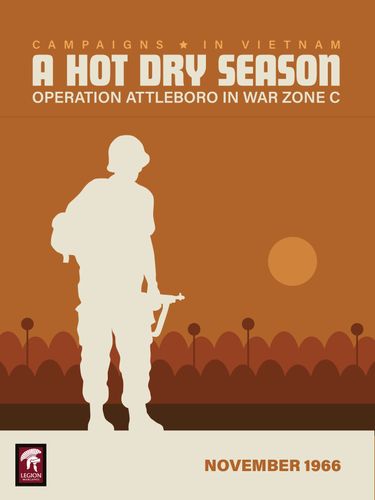|
Advertisement
|
A Hot Dry Season: Operation Attleboro in War Zone C

DescriptionA Hot Dry Season: Operation Attleboro in War Zone C (AHDS) is an operational-level game dealing with the National Liberation Front (NLF) Dry Season Offensive in the III Corps Tactical Zone (III CTZ) in November 1966 and the subsequent counterattack by forces under the command of Military Assistance Command, Vietnam (MACV). From the designer’s website: "To Military Assistance Command-Vietnam (MACV), Operation Attleboro was a meeting engagement in War Zone C that grew into the largest operation involving US Forces conducted in South Vietnam at that time. To the Central Office for South Vietnam (COSVN), Operation Attleboro was unexpected early contact by a force attempting to conduct an offensive that snowballed into a desperate defense and fighting withdrawal to protect precious logistic and command capabilities essential to their future operations in III Corps Tactical Zone (III CTZ). MACV grossly underestimated the National Liberation Front’s (NLF) capability to supply their own forces, tactically maneuver them, and evade detection in order to threaten US/Army of the Republic of Vietnam (ARVN) infrastructure and units when operating in close proximity to Peoples’ Liberation Forces of South Vietnam (PLAF – what are popularly known as “Viet Cong Main Force”) base areas in Cambodia. COSVN grossly underestimated the US’s capability to rapidly reinforce an area of operations using strategic mobility and rapidly employ such reinforcements almost immediately in the field. MACV underestimated the proclivity of COSVN to use PLAF forces confront and destroy threats to its logistics and supply system. COSVN erroneously expected US Forces to respond to tactical and operational dilemmas like the ARVN. To wit, responding to “Ambush and Bait” with dispersed pursuits of the ambushers on multiple axis, thus leaving some pursuing units vulnerable to destruction via “One Slow, Four Quick”. Both sides were unaware of flaws and gaps in their respective intelligence, surveillance and reconnaissance (ISR) networks, and the murky picture of active operations that would result from a clash of this magnitude, in the trying terrain of War Zone C. Neither side gained any lasting advantage from Operation Attleboro, though both sides missed opportunities to secure them." The game’s scale is Company as the primary unit size, day turns and a mile per hex. AHDS uses a concealed information/movement mechanism for NLF units and a limited information availability mechanism for both sides, and heavily emphasizes Intelligence, Surveillance and Reconnaissance (ISR) capabilities and their impact on revealing concealed/limited information units. The game uses a movement point system and combat result table mechanisms fires, air defense fire and ground combat. AHDS has an asymmetric component to its turns, as an Initiative player determines the order of resolution of Fires attacks and missions and then Operations (movement and combat). Within Operations, interactivity and reactions to phasing player action; reaction moves and hasty attacks may be performed by the non-phasing player as the phasing player’s turn is resolved. Uncertainty is added to victory and even game end in the campaign by the use of Operational Guidance chits which are selected before set up – neither side may be exactly certain what the other’s priorities are, which impacts victory conditions and player strategy as the game progresses. AHDS contains 7 scenarios: Introductory, Basic, and Intermediate, ranging from 3 to 10 game turns. The campaign is 25 turns long, but may, through Operational Guidance chit play referred to above, last 30 turns. AHDS is the first entry in a new series, Campaigns in Vietnam, which features a “Ground-Up Build” system. While sharing core concepts and “DNA” in resolution of play and movement/combat mechanisms, each title is built from the “Ground-Up” allowing specific tailoring of concepts and rules mechanisms in an attempt to accurately evoke the very different Campaigns fought during the Vietnam War from 1965-1975 and faithfully incorporate the dynamic changes in force structure and composition, weapons and ISR capabilities, specific operational goals and difficulties, and terrain and regional variances unique to Vietnam and the Vietnam War. Basic Information Game Components and Specifications —description from the publisher Game DiscussionsAdd CommentYou need to be logged in to comment. Insert Bullet List Please enter at least one item. Item: Item: Item: Item: Item: Insert Numeric List Please enter at least one item. Item: Item: Item: Item: Item: Insert Link Please enter the link of the website Optionally you can add display text Insert Email Please enter the email address Optionally add any display text Insert Image Please enter the link of the image Insert YouTube Video Please enter the link of the video Marketplace | ||||

Comments (0)